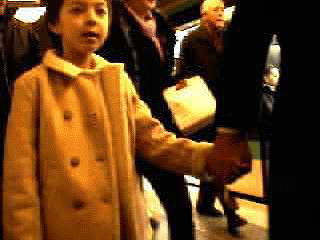Metro
Media perfomance: Aleksandra Dulic
Music Composition: Kenneth Newby
Presented at: INTERACTIVE FUTURES: New Media Crossing Boundaries, Faculty of Fine Arts, University of Victoria. Victoria International Film and Video Festival, Victoria; also presented at Western Front in 2002 Vancouver

Metro was created and performed as collaboration between Aleksandra Dulic and Kenneth Newby as a single-channel video installation with an immersive 5.1 channel audio system. For the Interactive Futures event in Victoria we incorporated a machine-vision system as input, to which we added our own performance. The work that resulted was a 30 – 40 minute performance.
The basis for the video content is documentary footage shot in the Paris Metro. The visual material includes portraits of riders captured as reflections in the windows of the trains, riders waiting at the station platforms, and trains traveling. . The open-ended nature of the metro footage made it easy to create a complex braid of movement, without beginning or end, through underground space and traffic. The overall composition moves from highly abstracted imagery–treated metro documentation footage--to pure documentary material not treated in any way. Animated geometric forms such as points, lines and planes are combined with the video to create abstracted imagery. The process allowed us to move back and forth between heavily affected images and the documentary images.


Metro is about the gaze; people filmed in Paris metro stations eventually become aware of the camera and look at the camera. This makes the viewer aware of being caught gazing at the people through the camera lens
The sound is made up of the Metro soundscape (trains recorded from inside and out, footsteps, talking etc), an original musical score, and a speech component that implies layers of "inner dialogue." These inner voices recite poetic and philosophic ideas on the subject of the gaze, voyeurism, watching and being watched.


The music is scored for string ensemble and percussion, and consists of a blend of high clustered glissandi harmonics and percussive patterns that complement the movement of the trains and passengers. The soundtrack is layered: multiple tracks of musical material are mixed with processed Metro soundscapes and the inner speech of the characters.
Metro combines methods of sequencing and transforming to explore the potentials of performing with prerecorded media elements. This work is presented via a performance-based editing system, which allows on-the-fly inputs and interfaces to animate the source material and the image-processing applications. Each process is independent, allowing one to work with multiple processes simultaneously.
Two streams of video drawn from the database of Metro material are blended, montaged, and processed. The visual language spans a spectrum from pure realism, with the original documentary material montaged and mixed, to a play of pure visual formalism. The large screen space can be broken up in a variety of ways by the masking and layout of the two video sources.
A computer system running our own interactive cinema software co-edits, with a performer, the presentation of aural and video components of the film. The interactive cinema software embodies a film editor’s compositional knowledge. One component of the interactive cinema-editing engine is a machine-vision system based on video-camera input. The camera provides information from the environment, such as direction of movement, relationship between foreground and background, etc, and our program analyses the data and looks for the action and motion vectors across the frame. This information is used to select and manipulate aural and visual components of the work.
All of these elements are mixed and composed in real time by a performer using a computer system with our interactive cinema software.